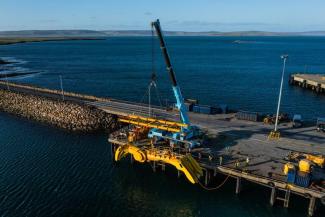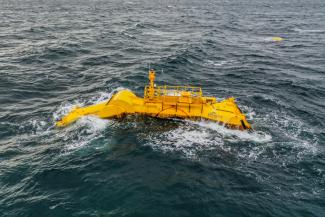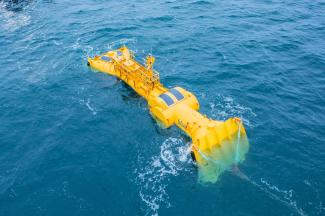Blue Star wave energy converter (WEC)
A floating device that converts the energy of ocean waves, providing local, reliable, renewable electricity for power and communications of offshore assets
At Mocean, we design, build, and deploy machines that convert the energy of ocean waves into electricity.
Wave energy is fundamentally an enabler: providing local, reliable, renewable power (and communications!) offshore, right where it is required. Wave energy converters (WECs) can be used to decarbonise existing assets and to electrify new developments that rely on, for example, all-electric systems and subsea resident vehicles like AUVs.
Our first product, the Blue Star wave energy converter (WEC), is based on learning accumulated through our Blue X prototype. Our WEC is:
- A floating, asymmetric, hinged raft with sloped sections at the front and rear called "wave channels", and a generator inside the hinge
- Waves cause a reciprocating motion about the hinge; this is damped and taken off as electrical energy via the generator, then exported via umbilical
- AI-optimised based on in-house software, resulting in high response sensitiity in a wide range of seas, enabling continuous power delivery
- Validated in wave tanks and at full-scale via successful rounds of at-sea trials - the first in 2021 and the second since February 2023 (ongoing)
- Third party selected versus competition - via internationally recognised IEA-OES evaluation criteria, Mocean technology has been competitively selected through 5 stage-gates in two major wave energy pre-commercial procurement programs.
Our design process and learning-by-doing approach have unlocked key technology benefits:
- Survivability - the WEC is passively survivable; it dives through steep ("extreme") waves to shed loads and avoid slamming; no end-stops or active braking are required
- Reliability - the WEC is a simple system with fundamentally two moving parts; it has been engineered based on a 25-year design life; the mooring is not particularly stressed as the WEC does not require to react against it for power conversion (it is 'self-referencing')
- Deployability - the combination of broad response to different waves and high survivability means the WEC is deployable in a vast range of global locations; self-referencing characteristics and slack mooring means it is depth agnostic; it passively weathervanes to align itself with dominant wave direction
- Integrability - high level of subsea system integration (see below); proven integration of solar panels on deck to feed comms, hotel loads, and mitigate seasonality of wave resource
By combining our WEC with subsea batteries, we can quickly re-establish stranded assets (e.g. shut-in wells due to electrical/communications failures), and replace long umbilicals, avoiding lengthy lead-times and the significant cost and carbon impact of tying these back to shore. We can power sensors for CCS leak monitoring, decommissioning activities, and many more applications. The combined impact is a combined reduction of costs and emissions, both direct (from power generation) and indirect (e.g. from manned vessel use and cables).
Mocean has been carrying out a flagship Net Zero Technology Centre demonstration project called Renewables for Subsea Power (RSP). This is a joint industry project demonstrating successful subsea system integration to power a micro-grid. System integration has historically been - and remains - a notable challenge for the energy transition; it is also a huge opportunity to pioneer and prove novel offshore solutions via wave energy.
RSP brings together technology developers (which Mocean leads), a technology integrator, and a growing number of Tier I operators. This full-scale first-of-a-kind commercial system is demonstrating power and over-the-horizon communications from wave energy to a subsea battery, AUV, and subsea control module. Our WEC has already been proven to TRL8 after at-sea trials in 2021; RSP is taking the complete system to TRL 7-8. A full-year offshore is planned, following initial deployment 3.5 nautical miles west from Orkney (Scotland) in February 2023.
| Specification Title | Specification Description |
|---|---|
|
Power rating
|
10-20kW
|
|
Dimensions & Mass
|
19.3m (L) x 7.6m (H) x 4.6m (D); 38 te
|
|
Communications
|
3G/4G, VHF, Wi-Fi, SatCom
|
Reviews
Sign up or log in to your explorer or platform subscription to get access to the reviews written about this technology.
The Technology Readiness Level (TRL) indicates the maturity level of novel technologies. Learn more about the TRL scale used by us.
[8/9]






